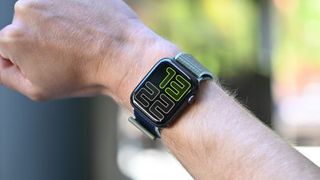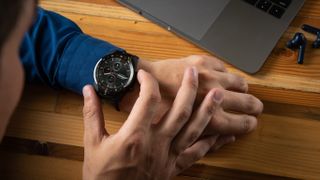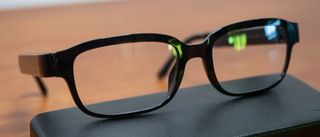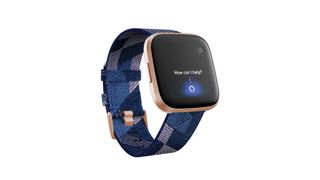Could your next smartwatch replace your phone?
One day, a wearable might be the only device you need

When did you last check what your smartwatch can actually do? If you’re lucky enough to have the newest Apple Watch, then you’ve got one super-smart device strapped to your arm.
The Apple Watch 5 has an always-on retina display that never sleeps (unless you tell it to). It can play songs, audiobooks and give you instant access to thousands of apps on the app store. With cellular connectivity, you can call, text and stream music without your phone. Its heart rate monitor and sensors allow for best-in-class exercise tracking and it has advanced ECG (electrocardiogram) heart-tracking tech built in. And that’s just the beginning.
Although wearable devices still may not be for everyone, we know as they get smarter they become more popular. According to the latest statistics from research company Strategy Analytics, global smartwatch shipments have grown 44% in the second quarter of 2019 alone, with Apple maintaining its top position with a 46% share of the global smartwatch market.

As smartwatches gain more and more features, it’s not hard to imagine a future in which we’re turning to our smart wearables to fulfil all of the functions of our smartphones – after all, if your Apple Watch has cellular connectivity these days it can already make and receive calls and send texts.
This begs the question: will advancing smartwatches make our smartphones redundant? And if not, what does the future hold for increasingly smarter and smaller wearable devices?
Where we're at now
Whereas fitness and activity trackers are solely focused on collecting health and fitness data, like the Fitbit Charge 3 or Garmin Vivosmart 4, smartwatches do more.
Sure, many also have plenty of health and fitness tracking features built in, but they also bring an interface to your wrist that allows you to view notifications, check your calendar, play music, interact with apps and, in some cases, even make and answer calls and texts.
Get daily insight, inspiration and deals in your inbox
Sign up for breaking news, reviews, opinion, top tech deals, and more.
Mike Feibus, a principal analyst and president of market insight company FeibusTech, believes those interested in data about their health and fitness still need more from their wearables.
“Smartwatches track a whole lot more than steps now, which is good. But users are still pining for more insights into their health and wellbeing, as opposed to just a flood of numbers,” he told TechRadar.

But those who want a wider suite of features are happy with what the market currently offers.
“People who love smartwatches as smartphone extensions are as happy as they’ve ever been,” he told us. “You can control music, read texts, monitor phone calls, respond to email. Battery life is better and platforms are more stable and user-friendly.”
We spoke to Donald Zhang, the VP of International Sales Marketing at smartwatch company Mobvoi, the brand behind the TicWatch range of wearables, about why users are increasingly interested in wearable tech.
“Users want to be connected wherever they go and smartwatches make this possible,” Zhang told us. “Before you would have to have your mobile phone with you wherever you go, and now that’s not a requirement anymore.”
He also told us that smartwatch buyers are becoming more diverse. Smartwatches no longer seem to be for early adopters, but there’s a rise in older users who, according to Mobvoi, are interested in staying connected and tracking their health. There’s also increasing interest in people who work in certain professions and can’t have their phone with them throughout the day, such as those working in nursing.
What do smartwatches need to replace phones?
Although plenty of smartphone features are being added to smartwatches, there’s still a long way to go before the device on your wrist can do the same everything that the one in your hand can.
One of the biggest hurdles is battery life. Although the Apple Watch Series 5 is one of the most advanced smartwatches currently on the market, it’s still only expected to last around 18 hours on a single charge with regular use.
The latest stats from the Rescue Time app suggest we spend more than three hours and five minutes on our phones every day, so for smartwatches to ever give us as much screen time as our phones, we need a battery boost.
Creating ways to either add bigger, better batteries to smartwatches or make charging more seamless is important to the future of wearable devices. We’ve seen plenty of user friendly, wireless charging options for the Apple Watch, like magnetic charging docks and stands, but solutions that don’t even require you to take a wearable off would be even better.
There are plenty of fitness trackers that run on batteries that only need replacing every six months, but there’s often a trade-off, such as a lack of a screen or reduced functionality.
Another solution would be trackers that are solar-powered or self-powered by heat, sweat or your own movement throughout the day. This kind of tech hasn’t found its way to big-name devices yet, but some smaller startups have been working on tech that’s designed to run on kinetic energy.
For example, the team behind Element1 was looking for crowdfunded investment a few years back (and unfortunately never found it). There are also several research teams investigating the use of kinetic energy for smart clothing, like this nanogenerator from the University of South Korea that uses textiles to generate power.
Switching from phones to watches isn’t just about tech either, but the way we behave and adopt habits. Battery life is important in this respect because if you have to take a wearable device off to charge it throughout the day, there’s a big chance you either won’t ever put it on again, forget to put it on regularly or stop yourself from developing habitual behaviour when it comes to remembering to wear it often.
Of course, battery life is just one element to consider. Smartwatches will also need better screens, more features and advanced connectivity to compete with our smartphones. But there’s one big problem: space.
The key challenge of smartwatches is keeping the device itself slim, nice-looking and functional at the same time as adding new internal chips, sensors, features and advanced batteries.

Could smart eyewear be the future?
Rather than cramming more tech onto our wrists, maybe we need to look elsewhere and ask: what if the future of smartwatches isn’t about watches at all?
Smart glasses with voice assistants built-in to answer questions for us or reply to emails or with AR (augmented reality) capabilities to overlay virtual objects over the real world have been in development for some time now. Remember when Google tried to own this space with Google Glass?
Although one single company is yet to create mainstream smart glasses, that could all be set to change soon. Earlier this year, Amazon announced its Echo frames, a pair of smart specs with Alexa built in. And rumors have been mounting for some time that Apple is working on its own pair of smart glasses with integrated AR tech.
If smart glasses manage to take off, there might not be much use for smartphones or smartwatches in the future because our eyewear will handle calls, texts, web browsing and music streaming all from a small interface in front of our eyes.
Smarter watches for smarter living
If smartwatches are going to become widely used in the future, there are many who believe they may need to add more value than our smartphones – not just mimic the same features.
Our wearables might become vital for our day-to-day lives in the future if they work well with other kinds of tech within our homes. For example, imagine if your Apple Watch could collect all kinds of data about your body and your habits. This could then be fed into your smart home devices to create highly tailored, personalized experiences.
Your smartwatch could tell your smart home you’re showing signs of stress via its sensors and that you have a meeting tomorrow via your emails. This could then be used to tweak your smart lights, get your bath running and turn the heating on to get you into a better state of mind.

“We’re starting to see Amazon’s Alexa and Google Home integrated into wearables,” Feibus told us. Most recently, Fitbit launched the Versa 2 with Alexa integration. Not only could this offer up tailored experiences, it also makes sense as a way to interact with the AI voice assistants in our homes because your smartwatch is always on you. “That’s a quick way to mobilize home automation command and control to spots in the house where the smart speakers aren’t,” he explained.
Using AI to find out more about users is a key focus for Mobvoi. “In the future, we’re looking at integrating our smartwatches and AI with the smart home,” Zhang says. He explains that this could be anything from gesture control on your smartwatch turning on the lights in your house or speaking to your smartwatch to turn on your TV.
But let’s not forget that even if tech advances enough to bring better battery, functionality and smart assistants to your wrist, it doesn’t mean everyone will be so quick to ditch their phones and change their habits right away.
“It depends on the way people choose to use this technology,” Zhang says. “Some individuals like having a phone and a bigger screen, while others are quite happy to use a smaller watch face.” The Mobvoi team has found that some users are even opting to trade in their smartphone for an older ‘dumb’ phone and choosing a smartwatch instead.
We may not know how smartwatches will develop in the future just yet, and whether they’ll replace our smartphones or that same smart functionality will come to advanced eyewear. But maybe a more useful answer isn’t to advance one particular type of technology and do away with another, but to give people more choice about the devices they choose to use.
- Best smartwatch 2019: the top wearables you can buy today
Becca is a contributor to TechRadar, a freelance journalist and author. She’s been writing about consumer tech and popular science for more than ten years, covering all kinds of topics, including why robots have eyes and whether we’ll experience the overview effect one day. She’s particularly interested in VR/AR, wearables, digital health, space tech and chatting to experts and academics about the future. She’s contributed to TechRadar, T3, Wired, New Scientist, The Guardian, Inverse and many more. Her first book, Screen Time, came out in January 2021 with Bonnier Books. She loves science-fiction, brutalist architecture, and spending too much time floating through space in virtual reality.
